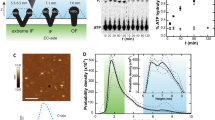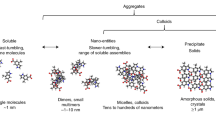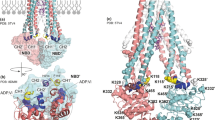Key Points
-
Drug discovery for membrane targets will be a major focus for the foreseeable future.
-
However, the lack of essential high-resolution structural details at the molecular level, and the well-acknowledged technical difficulties that are associated with the crystallography of membrane proteins, have hampered the development of rational drug discovery for membrane targets.
-
NMR is a tool that is used to derive local (magnetic) information at the atomic level and is, therefore, limited by complexity in large molecules.
-
However, defining ligand–protein interactions does, fortuitously, require local information and so NMR comes into its own. Observing drugs at their membrane-embedded target directly is an important challenge that solid-state NMR is now addressing
-
This review describes the application of solid-state NMR for detecting ligands at their site of action, resolving drug structures at their site of action, defining target binding sites, resolving ligand orientation, resolving bound drug dynamics and assessing drug partitioning.
Abstract
Observing drugs and ligands at their site of action in membrane proteins is now possible through the use of a development in biomolecular NMR spectroscopy known as solid-state NMR. Even large, functionally active complexes are being examined using this method, with structural details being resolved at super-high subnanometre resolution. This is supplemented by detailed dynamic and electronic information about the surrounding ligand environment, and gives surprising new insights into the way in which ligands bind, which can aid drug design.
This is a preview of subscription content, access via your institution
Access options
Subscribe to this journal
Receive 12 print issues and online access
$209.00 per year
only $17.42 per issue
Buy this article
- Purchase on Springer Link
- Instant access to full article PDF
Prices may be subject to local taxes which are calculated during checkout





Similar content being viewed by others
References
Terstappen, G. C. & Reggiani, A. In silico research in drug discovery. Trends Pharmacol. Sci. 22, 23–26 (2001).
Drews, J. Drug discovery: a historical perspective. Science 287, 1960–1964 (2000).
Doyle, D. A. et al. The structure of the potassium channel: molecular basis of K+ conduction and selectivity. Science 280, 69–77 (1998).
Denker, B. M., Smith, B. L., Kuhajda, F. P. & Agre, P. Identification, purification, and partial characterization of a novel Mr28,000 integral membrane protein from erythrocytes and renal tubes. J. Biol. Chem. 263, 15634–15642 (1988).
Tucker, J. & Grisshammer, R. Purification of a rat neurotensin receptor expressed in Escherichia coli. Biochem. J. 317, 891–899 (1996).
Seifert, R. et al. Different effects of Gsa splice variants on β2-adrenoreceptor-mediated signaling. The β2-adrenoreceptor coupled to the long splice variant of Gsa has properties of a constitutively active receptor. J. Biol. Chem. 273, 5109–5116 (1998).
Creemers, A. F. L. et al. Solid state 15N NMR evidence for a complex Schiff base counterion in the visual G-protein-coupled receptor rhodopsin. Biochemistry 38, 7195–7199 (1999).
Vosegaard, T. & Nielsen, N. C. Towards high-resolution solid-state NMR on large uniformly 15N- and [13C, 15N]-labeled membrane proteins in oriented lipid bilayers. J. Biomol. NMR 22, 225–247 (2002).
Riek, R., Pervushin, K. & Wüthrich, K. TROSY and CRINEPT: NMR with large molecular and supramolecular structures in solution. Trends Biochem. Sci. 25, 462–468 (2000). This paper reviews the potential of using new solution-state NMR for the structural determinations of larger (30100 kDa) purified proteins.
Watts, A. et al. in Methods in Molecular Biology: Techniques in Protein NMR (ed. Downing, K.) (Humana, Totowa, New Jersey, 2004).
Roberts, G. C. K. Applications of NMR in drug discovery. Drug Discov. Today 5, 230–240 (2000).
Pellecchia, M., Sem, D. S. & Wüthrich, K. NMR in drug discovery. Nature Rev. Drug. Discov. 1, 211–219 (2002). References 11 and 12 are good and comprehensible reviews of solution-state NMR methods to study ligand-target interactions.
Shuker, S., Hajduk, P., Meadows, R. & Fesik, S. Discovering high-affinity ligands for proteins: SAR by NMR. Science 274, 1531–1534 (1996).
Watts, A. Direct studies of ligand–receptor interactions and ion channel blocking. Mol. Memb. Biol. 19, 267–275 (2002).
Watts, A. et al. Membrane protein structure determination by solid state NMR. Nat. Prod. Rep. 16, 419–423 (1999).
Watts, A. NMR of drugs and ligands bound to membrane receptors. Curr. Opin. Biotechnol. 10, 48–53 (1999).
Watts, A. Structural resolution of ligand–receptor interactions in functional, membrane-embedded receptors and proteins using novel, non-perturbing solid state NMR methods. Pharm. Pharm. Comm. 5, 7–13 (1999).
Spooner, P. J. R., Rutherford, N., Watts, A. & Henderson, P. J. F. NMR observation of substrate in the binding site of an active sugar H+ symport protein in native membranes. Proc. Natl Acad. Sci. USA 91, 3877–3881 (1994).
Spooner, P. J. R., Veenhoff, L. M., Watts, A. & Poolman, B. Structural information on a membrane transport protein from nuclear magnetic resonance spectroscopy using sequence-selective nitroxide labeling. Biochemistry 38, 9634–9639 (1999)
Creuzet, F. et al. Determination of membrane-protein structure by rotational resonance NMR: bacteriorhodopsin. Science 251, 783–786 (1991). This was the first example of distance measurements in a membrane receptor using solid-state NMR to determine ligand (retinal) structure.
Gröbner, G. et al. Observation of light-induced structural changes of retinal within rhodopsin. Nature 405, 810–813 (2000).
Ulrich, A. S., Wallat, I., Heyn, M. P. & Watts, A. Re-orientation of retinal in the M-photointermediate of bacteriorhodopsin. Nature Struct. Biol. 2, 190–192 (1995).
Carravetta, M. et al. Protein-induced bonding perturbation of the rhodopsin chromophore detected by double-quantum solid-state NMR. J. Am. Chem. Soc. 126, 3948–3953 (2004).
Blundell, T. L., Jhoti, H. & Abell, C. High-throughput crystallography for lead discovery in drug design. Nature Rev. Drug Discov. 1, 45–54 (2002).
Toyoshima, C. & Nomura, H. Structural changes in the calcium pump accompanying the dissociation of calcium. Nature 418, 605–611 (2002). This paper presents the first high-resolution structure of a P-type membrane ATPase in which the ligand structure and conformational changes are defined.
Watts, J. A., Watts, A. & Middleton, D. A. A model of reversible inhibitors in gastric H+/K+-ATPase binding site determined by rotational echo double resonance NMR. J. Biol. Chem. 276, 43197–43204 (2001).
Middleton, D. A., Rankin, S., Esmann, M. & Watts, A. Structural insights into the binding of cardiac glycosides to the digitalis receptor revealed by solid-state NMR. Proc. Natl Acad. Sci. USA 97, 13602–13607 (2000).
Kim, C. G., Watts, J. A. & Watts, H. Ligand docking in the gastric H+/K+-ATPase — homology modelling of reversible inhibitor sites. J. Med. Chem. (in the press).
Miyazawa, A., Fujiyoshi, Y., Stowell, M. & Unwin, N. Nicotinic acetylcholine receptor at 4.6Å resolution: transverse tunnels in the channel wall. J. Mol. Biol. 288, 765–786 (1999).
Miyazawa, A., Fujiyoshi, Y. & Unwin, N. Structure and gating mechanism of the acetylcholine receptor pore. Nature 424, 949 (2003).
Fraenkel, Y., Gershoni, J. M. & Navon, G. NMR analysis reveals a positively charged hydrophobic domain as a common motif to bound acetylcholine and D-tubocurarine. Biochemistry 33, 644–650 (1994).
Williamson, P. T. F., Watts, J. A., Addona, G. H., Miller, K. W. & Watts, A. Dynamics and orientation of N+(CD3)3-bromoacetylcholine bound to its binding site on the nicotinic acetylcholine receptor. Proc. Natl Acad. Sci. USA 98, 2346–2351 (2001).
Williamson, P. T. F., Gröbner, G., Spooner, P. J. R., Miller, K. W. & Watts, A. Probing the agonist binding pocket on the nicotinic acetylcholine receptor: a high resolution solid state NMR approach. Biochemistry 37, 10854–10859 (1998).
Gallivan, J. P. & Dougherty, D. A. Cation–π interactions in structural biology. Proc. Natl Acad. Sci. USA 96, 9459–9464 (1999).
Sabbagh, M., Lukas, R., Sparks, D. & Reid, R. The nicotinic acetylcholine receptor, smoking, and Alzheimer's disease. J. Alzheimers Dis. 4, 317–325 (2002).
Shytle, R. et al. Cholinergic modulation of microglial activation by α7 nicotinic receptors. J. Neurochem. 89, 337–343 (2004).
Terry, A. J. & Buccafusco, J. The cholinergic hypothesis of age and Alzheimer's disease-related cognitive deficits: recent challenges and their implications for novel drug development. J. Pharmacol. Exp. Ther. 306, 821–827 (2003).
Romano, J. A possible explanation for nicotine's neuroprotective effect. Neurol. Rev. 12, 4 (2004).
Arehart-Treichel, J. A. Role for nicotine in Alzheimer's, other disorders. Psych. News (17 March 2000).
Wilens, T. E. et al. A pilot controlled clinical trial of ABT-418, a cholinergic agonist, in the treatment of adults with attention deficit hyperactivity disorder. Am. J. Psych. 156, 1931–1937 (1999).
Kelly, C. & McCreadie, R. Smoking habits, current symptoms, and premorbid characteristics of schizophrenic patients in Nithsdale, Scotland. Am. J. Psych. 156, 1751–1757 (1999).
Pebay-Peyroula, E., Rummel, G., Rosenbusch, J. P. & Landau, E. M. X-ray structure of bacteriorhodopsin at 2.5 angstroms from microcrystals grown in lipidic cubic phases. Science 277, 1676–1681 (1997).
Luecke, H., Schobert, B., Richter, H. T., Cartailler, J. P. & Lanyi, J. K. Structure of bacteriorhodopsin at 1.55Å resolution. J. Mol. Biol. 291, 899–911 (1999).
Gröbner, G. et al. Macroscopic orientation of natural and model membranes for structural studies. Anal. Biochem. 254, 132–136 (1997).
Kamihira, M. et al. Structural and orientational constraints of bacteriorhodopsin in purple membranes determined by oriented-sample solid-state NMR spectroscopy. J. Struct. Biol. 149, 7–16 (2005).
Merlitz, H., Burghardt, B. & Wenzel, W. Stochastic tunneling method for high-throughput database screening. Nanotechnology 1, 44–47 (2003).
Fraser, D. M., Van Gorkom, L. C. M. & Watts, A. Partitioning behaviour of 1- hexanol into lipid membranes as studied by deuterium NMR spectroscopy. Biochim. Biophys. Acta 1069, 53–60 (1991).
Middleton, D. A., Reid, D. G. & Watts, A. A combined quantitative and mechanistic study of drug–membrane interactions using a novel 2H NMR approach. J. Pharm. Sci. 93, 507–514 (2004).
Hu, J. G. et al. Early and late M intermediates in the bacteriorhodopsin photocycle: a solid-state NMR study. Biochemistry 37, 8088–8096 (1998).
Jaroniec, C. P. et al. Measurement of dipolar couplings in a uniformly 13C/15N labeled membrane protein: distances between the Schiff Base and aspartic acids in the active site of bacteriorhodopsin. J. Am. Chem. Soc. 123, 12929–12930 (2001).
Lemaitre, V. et al. New insights onto the bonding arrangements of L- and D-glutamates from solid state 170 NMR. Chem. Phys. Lett. 371, 91–97 (2003).
Lansing, J. C., Hu, J. G., Belenky, M., Griffin, R. G. & Herzfeld, J. Solid-state NMR investigation of the buried X-proline peptide bonds of bacteriorhodopsin. Biochemistry 42, 3586–3593 (2003).
Jaroniec, C. P. et al. Measurement of dipolar couplings in a uniformly 13C-15N-labeled membrane protein: distances between the Schiff Base and aspartic acids in the active site of Bacteriorhodopsin. J. Am. Chem. Soc. 123, 12929–12930 (2001).
Castellani, F. et al. Structure of a protein determined by solid-state magic angle-spinning NMR spectroscopy. Nature 420, 98–102 (2003).
Palczewski, K. et al. Crystal structure of rhodopsin: a G protein-coupled receptor. Science 277, 687–690 (2000).
Opella, S. J. NMR and membrane proteins. Nature Struct. Biol. 4 (Suppl.), 845–848 (1997). This is a good review of solid-state NMR structure determinations for membrane proteins, which is comprehensibly written and well illustrated.
Griffin, R. G. Dipolar recoupling in MAS spectra of biological solids. Nature Struct. Biol. 5, 508–512 (1998). This paper contains descriptions of dipolar recoupling methods, and is accessible to specialists and nonspecialists alike.
Tycko, R. Biomolecular solid state NMR: advances in structural methodology and applications to peptide and protein fibrils. Annu. Rev. Phys. Chem. 52, 575–606 (2001).
Thompson, L. K. Solid state NMR studies of the structure and mechanisms of proteins. Curr. Opin. Struct. Biol. 12, 661–669 (2002).
Zech, S. G., Olejniczak, E., Hajduk, P., Mack, J. & McDermott, A. E. Characterization of protein–ligand interactions by high-resolution solid-state NMR spectroscopy. J. Am. Chem. Soc. 126, 13948–13953 (2004).
Bernstein, J. Polymorphism in Molecular Crystals (Oxford Univ. Press, Oxford, 2002).
Lemaitre, V., Smith, M. E. & Watts, A. A review of oxygen-17 solid state NMR of organic materials: towards biological applications. Solid State Nuc. Mag. Res. 26, 215–235 (2004).
Levitt, M. H., Raleigh, D. P., Creuzet, F. & Griffin, R. G. Theory and simulations of homonuclear spin pair systems in rotating solids. J. Chem. Phys. 92, 6347–6364 (1990).
Guillon, T. Introduction to rotational-echo double resonance NMR. Conc. Mag. Res. 10, 277–289 (1998).
Caira, M. R. in Design of Organic Solids 163–208 (Springer-Verlag, Heidelberg, 1998).
Threlfall, T. L. Analysis of organic polymorphs. A review. Analyst 120, 2435–2460 (1995).
Yu, L., Reutzel, S. M. & Stephenson, G. A. Physical characterization of polymorphic drugs: an integrated characterization strategy. Pharm. Sci. Technol. Today 1, 118–127 (1999).
Portieri, A., Harris, R. K., Fletton, R. A. & Lancaster, R. W. Effects of polymorphic differences for sulfanilamide, as seen through 13C and 15N solid state NMR, together with shielding calculations. Magn. Reson. Chem. 42, 313–320 (2004).
Apperley, D. C. et al. Sulfathiazole polymorphism studied by magic-angle spinning NMR. J. Pharm. Sci. 88, 1275–1280 (1999).
Midleton, D. A. et al. The conformation of an inhibitor bound to gastric proton pump. FEBS Letts. 410, 269–274 (1997).
Acknowledgements
The work described here from this group was supported by the European Union (EU), the Medical Research Council (MRC) UK, the Biotechnology and Biological Sciences Research Council (BBSRC), the Engineering and Physical Sciences Research Council (EPSRC) and the Higher Education Funding Council for England (HEFCE), with commercial support from Varian Inc. and Magnex Scientific Ltd., GlaxoSmithKline, Syngenta, Nestec and the Cheil Jedang Corporation.
Author information
Authors and Affiliations
Ethics declarations
Competing interests
The author declares no competing financial interests.
Related links
Glossary
- TUMBLING
-
A term used to describe molecules moving freely in solution and reorientating themselves quickly with respect to any given point.
- CHEMICAL SHIFT
-
The chemical shift of a particular nucleus is a measure of the dependence of the resonance frequency of the nucleus on its chemical environment.
- ASSIGNMENT
-
The process of attributing a resonance in an NMR spectrum to a particular nucleus in a molecule.
Rights and permissions
About this article
Cite this article
Watts, A. Solid-state NMR in drug design and discovery for membrane-embedded targets. Nat Rev Drug Discov 4, 555–568 (2005). https://doi.org/10.1038/nrd1773
Issue Date:
DOI: https://doi.org/10.1038/nrd1773
This article is cited by
-
In vivo NMR spectroscopy
Nature Reviews Methods Primers (2023)
-
Further Characterization of 394-GHz Gyrotron FU CW GII with Additional PID Control System for 600-MHz DNP-SSNMR Spectroscopy
Journal of Infrared, Millimeter, and Terahertz Waves (2016)
-
Mutation induced structural variation in membrane proteins
Chemical Research in Chinese Universities (2013)
-
NMR of molecules interacting with lipids in small unilamellar vesicles
European Biophysics Journal (2007)



